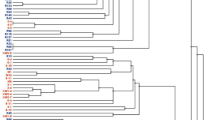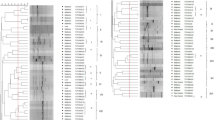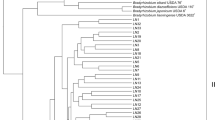Abstract
This study was carried out to examine the possible genetic diversity that may occur among Frankia strains that nodulate C. equisetifolia in Mexico growing in the site of introduction, the cost of the Golf of Mexico, as well in the highlands. DNA extracted from reference cultures of Casuarina infecting Frankia strains, from field collected nodules (two trees of each of 14 sites and 3–5 analyzed lobes of each nodule) or from young nodules obtained from plants growing at the growth chamber and inoculated with field nodules, were used as the template in PCR reaction with primers targeting two DNA regions, one of the ribosomal operon and the other in the nif operon. PCR products were analyzed by using a set of recommended restriction enzymes. Six PCR-RFLP groups were detected after digestion with combination of enzymes BstUI and CfoI of the nif region, and four PCR-RFLP groups with enzymes NciI and ScrFI in the ribosomal region. Reference strains showed similar patterns and were assigned in group 1 along with an uncultured strain. nifD-K PCR-RFLP groups allowed a better understanding of the diversity among nodular Frankia strains than those observed in the rrs PCR-RFLP groups.

Similar content being viewed by others
References
Bosco M, Fernández M, Simonet P, Materassi R, Normand P (1992) Evidence that some Frankia strains are able to cross boundaries between Alnus and Elaeagnus host specificity groups. Appl Environ Microbiol 58:1569–1576
Chacalo A, Fernández R (1995) Los árboles nativos e introducidos utilizados en la reforestación de la Cd. de México. Ciencia 46:383–393
Clawson ML, Benson DR (1999) Natural diversity of Frankia strains in actinorhizal root nodules from promiscuous hosts in the family Myricaceae. Appl Environ Microbiol 65:4521–4527
Cruz-Cisneros R, Valdés M (1990) Ecological aspects of the actinorhizal plants growing in the Basin of Mexico. Nitrogen Fixing Trees Res Rep 8:42–47
Dawson JO (1990) Interactions among actinorhizal and associated plant species. In: Schwintzer CR, Tjepkema JD (eds) The Biology of Frankia and Actinorhizal Plants. Academic Press, San Diego, California, pp 299–316
Gtari M, Brusetti L, Aouani MA, Daffonchio D, Boudabous A (2002) Frankia nodulating Alnus glutinosa and Casuarinaceae in Tunisia. Ann Microbiol 52:145–153
Huguet V, McCray Batzli J, Zimpfer JF, Normand P, Dawson JO, Fernandez MP (2001) Diversity and specificity of Frankia strains in nodules of sympatric Myrica gale, Alnus incana, and Shepherdia canadensis determined by rrs gene polymorphism. Appl Environ Microbiol 67:2116–2122
Huguet V, Mergeay M, Cervantes E, Fernandez MP (2004) Diversity of Frankia strains associated to Myrica gale in Western Europe: impact of host plant (Myrica vs Alnus) and of edaphic factors. Environ Microbiol 6:1032–1041
Huguet, V., Gouy, M., Normand, P., Zimpfer, J. F., and Fernandez, M.P. 2005.
Jamann, S., Fernandez, M. P. and Normand, P. 1993.Typing method for N2-fixing bacteria based on PCR RFLP application to the characterization of Frankia strains. Molecular Ecology 2:17–26.
Maggia L, Nazaret S, Simonet P (1992) Molecular characterization of Frankia isolates from Casuarina equisetifolia root nodules harvested in West Africa (Senegal and Gambia). Acta Oecologica 13:453–461
Maggia L, Prin Y, Picard B, Goullet P (1993) Esterase diversity among 46 Frankia strains isolated from Casuarina equisetifolia in West Africa. Can J Microbiol 39:709–714
Nalin R, Domenach AM, Normand P (1995) Molecular structure of the Frankia spp. nifD-K intergenic spacer and design of Frankia genus compatible primer. Mol Ecol 4:483–491
Normand P, Cournoyer B, Simonet P, Nazaret S (1992) Analysis of ribosomal RNA operon in the actinomycete Frankia. Gene 111:119–124
Normand P, Lapierre P, Tisa L, Gogarten JP, Alloisio N, Bagnarol E, Bassi CA, Berry AM, Bickhard DM, Choisne N, Couloux A, Cournoyer B, Cruveiller S, Daubin V, Demange N, Francino MP, Goltsman E, Huang Y, Kopp O, Labarre L, Lapidus A, Lavire C, Marechal J, Martinez M, Mastronunzio JE, Mullin BC, Niemann J, Pujic P, Rawnsley T, Rouy Z, Schenowitz C, Sellstedt A, Tavares F, Tomkins JP, Vallenet D, Valverde C, Wall L, Wang Y, Medigue C, Benson DR (2007) Genome characteristics of facultatively symbiotic Frankia sp. strains reflect host range and host plant biogeography. Genome Res 17:7–15
Pérez O, Olivera H, Vázquez L, Valdés M (1999) Genetic characterization of Mexican Frankia strains nodulating Casuarina equisetifolia. Can J Bot 77:1214–1219
Ritchie NJ, Myrold DD (1999) Geographic distribution and genetic diversity of Ceanothus-infective Frankia strains. Appl Environ Microbiol 65:1378–1383
Rouvier C, Nazaret S, Fernández MP, Picard B, Simonet P, Normand P (1992) rrn and nif intergenic spacers and isozyme patters as tools to characterize Casuarina- infective Frankia strains. Acta Ecologica 13:487–495
Rouvier C, Nazaret S, Prin Y, Redell P, Simonet P, Normand P (1996) Genetic diversity among Frankia strains nodulating members of the family Casuarinaceae in Australia Revealed by PCR and restriction fragment length polymorphism analysis with crushed root nodules. Appl Environ Microbiol 62:979–985
Saitou N, Nei M (1987) The neighbor-joining method: a new method for reconstructing phylogenetic trees. Mol Biol Evol 2:112–118
Simonet P, Navarro E, Rouvier C, Reddell P, Zimpfer J, Dommergues Y, Bardin R, Combarro P, Hamelin J, Domenach A-M, Gourbière F, Prin Y, Dawson JO, Normand P (1999) Co-evolution between Frankia populations and host plants in the family Casuarinaceae and consequent patterns of global dispersal. Environ Microbiol 1:525–533
Torrey JG, Racette S (1989) Specificity among the Casuarinaceae in root nodulation by Frankia. Plant Soil 118:157–164
Valdés M, Cayetano-Rodrigo A (1998) L’utilization du filao (Casuarina equisetifolia) au Mexique. Le Flamboyant 47:31–33
Valdés M, Vásquez L, Pérez NO (2001) Genetic markers (RAPDs and, rep PCR) for ecological studies of the Nitrogen fixing symbiosis Frankia-Casuarina. Eur For Res Net News 34:27–29
Vásquez L, Cruz-Cisneros R, Valdés M (2000) Presencia de nódulos fijadores de nitrógeno en raíces de Casuarina spp. México. Ciencia Forestal 25:93–102
Zhang Z, Lopez MN, Torrey JG (1984) A comparison of cultural characteristics and infectivity of Frankia isolates from root nodules of Casuarina species. Plant Soil 78:79–90
Zimpfer JF, Kennedy GJ, Smyth CA, Hamelin J, Navarro E, Dawson JO (1999) Localization of Casuarina-infective Frankia near Casuarina cunninghamiana trees in Jamaica. Can J Bot 77:1248–1256
Acknowledgements
The authors would like to thank to the Mexican Council of Science and Technology (CONACYT) for providing support for this research through the grant No. 48044. YTC acknowledges support from CONACYT through a M Sc scholarship. We are also grateful to Drs. J. J. Peña-Cabriales (CINVESTAV Irapuato, Gto.), Juan Florencio Leyva (Instituto Tecnológico de Tlajomulco, Jalisco), and Alberto Mendoza (CBG/IPN) for providing C.quisetifolia field nodules. We acknowledge the anonymous reviewers for their most useful criticism to the manuscript.
Author information
Authors and Affiliations
Corresponding author
Rights and permissions
About this article
Cite this article
Cabrera, Y.T., Valdés, M. Different genetic groups of Frankia within the root nodules of Casuarina growing in Mexico. Symbiosis 50, 45–50 (2010). https://doi.org/10.1007/s13199-009-0034-x
Received:
Accepted:
Published:
Issue Date:
DOI: https://doi.org/10.1007/s13199-009-0034-x




